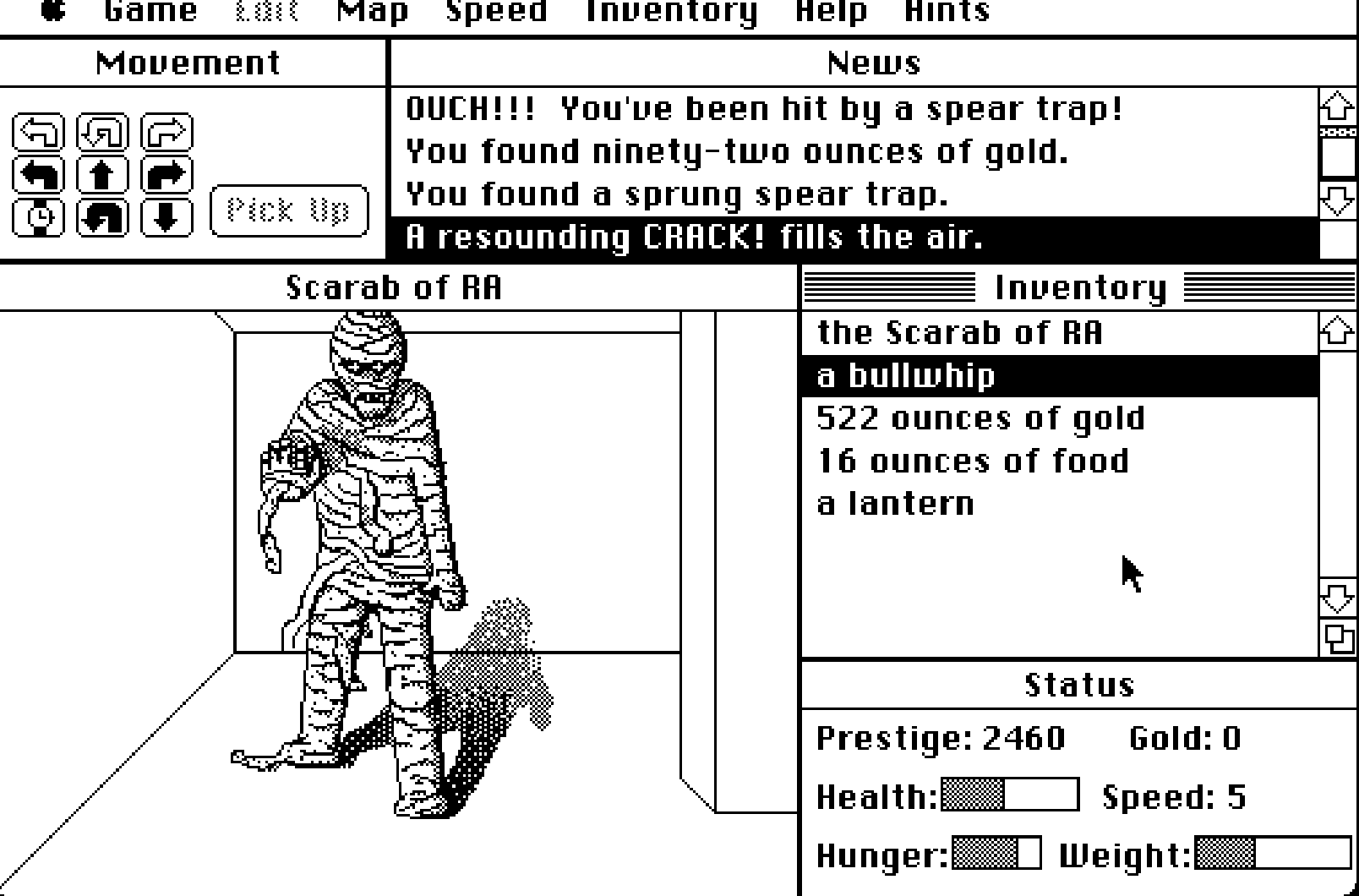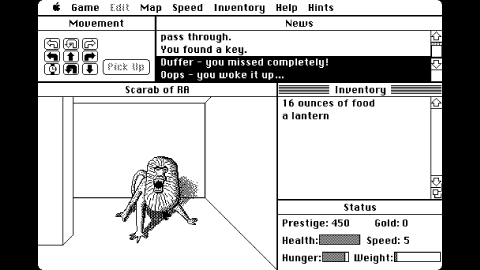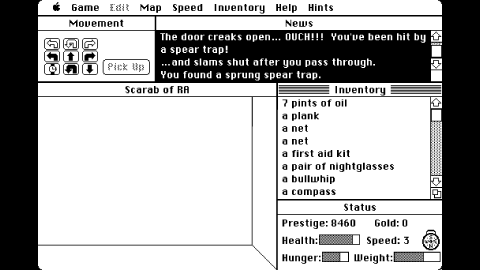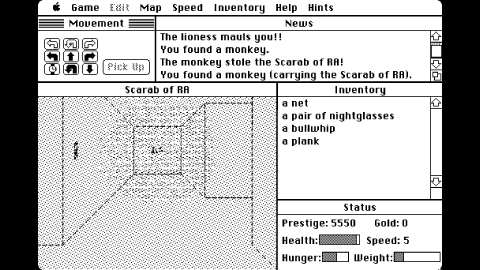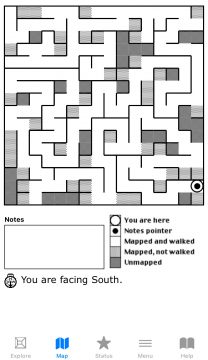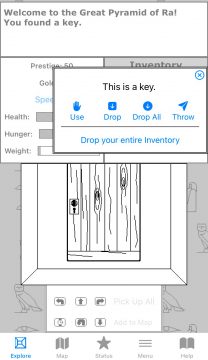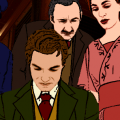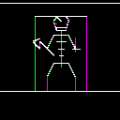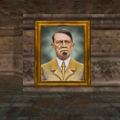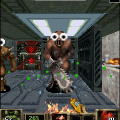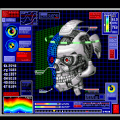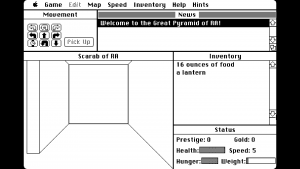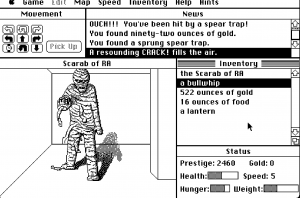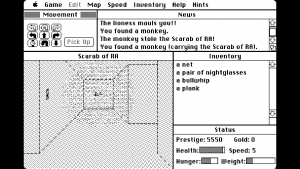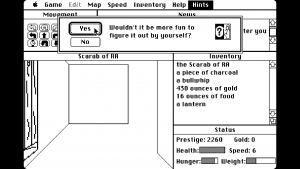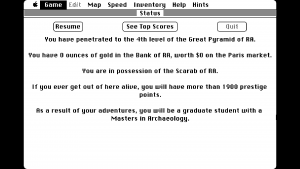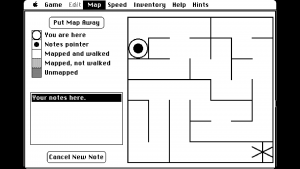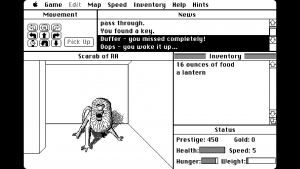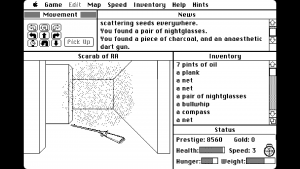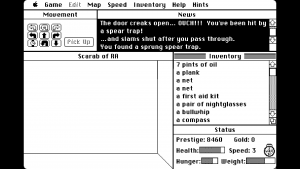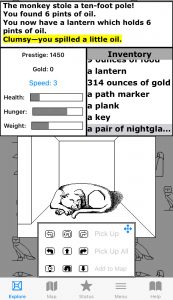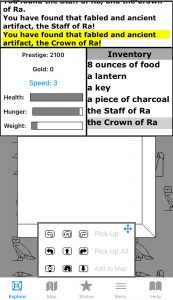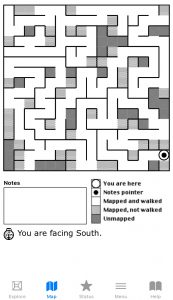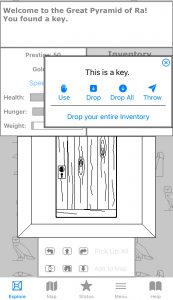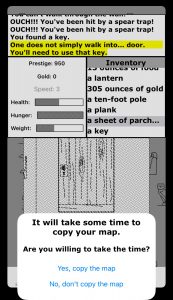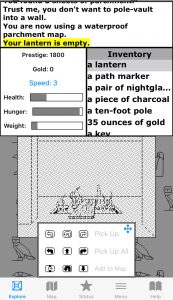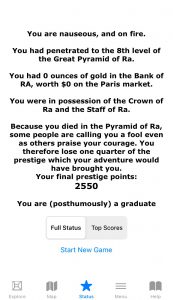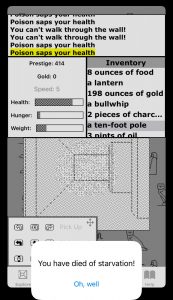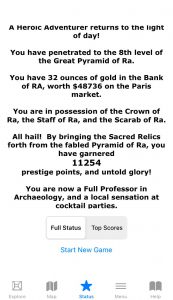Scarab of Ra (sometimes spelled “Scarab of RA“) seems like the quintessential 3D roguelike…at first. Sure, it’s a randomized trek through blocky, mostly-featureless hallways, and yes, permadeath is almost a certainty. However, the game rejects one of the key components that the genre has come to expect: combat. To create a greater emphasis on inventory-based problem solving, there are no traditional RPG stats, nor is there an experience system. Playing like a marriage of Rogue, 3D Monster Maze, and a point-and-click adventure, Scarab of Ra takes a decidedly western approach to adventuring: perseverance won’t make you stronger, it’ll only wear you down until you can’t go on.
Our hero, and the game’s only living human character, is a faceless archaeology undergrad exploring the first-person labyrinth that is the Great Pyramid of Ra. Black arrow buttons move the player in cardinal directions, while white ones look left, right, or back as long as they’re held. The watch icon is for waiting, an action which won’t be especially useful at the outset. Though it’s all very straightforward, modern audiences may find it awkward to click the HUD for movement.
Exploring the pyramid is all for the sake of finding the Crown, Staff, and Scarab of Ra: three fabled treasures that must be carried together to the end of a level in order to win the game. You may not happen upon even one of these items before your run comes to an end, but as the screenshots show, it is possible to find all three relatively early, or to even find two at once.
Since you’re guaranteed to get lost, Scarab of Ra allows you to mark your path with notes on a progressively populated in-game map, or with notes on walls using found pieces of charcoal. You may also find pre-existing text on the walls: aside from hieroglyphics, there are messages such as “this is/isn’t the path to the exit” which may or may not prove to be true. These give the impression of being left by previous players, but this isn’t an Oregon Trail “peperony and chease” situation.
The pyramid is compartmentalized by floor, with each one requiring a key in order to proceed to the next. Upon clearing a floor, the door to the previous becomes mysteriously locked, leaving you to wonder why this ancient, presumably stone tomb has wooden doors that are fully intact. While you’ll always start at the northwest corner of the map and find the exit at the southeast, the floors become more complex as you progress, both in size and variety.
Despite the scope of these later floors, freedom of exploration is a luxury. The player’s Hunger meter and active lantern oil are gradually depleted with each action, and a variable Speed value determines just how gradually. Proceed slowly, and you might not trigger a trap – conserving Health, but at the expense of your resources. Moving carelessly can eventually become a death sentence, so Scarab of Ra expects you to conserve by thinking through every choice. If you’re the sort of player who likes to beat your own high score, it’s apparently possible to go as far as floor 199 and beyond.
Health can be restored with reusable first aid kits, while Hunger can be managed with lunch pails that add to your food supply. While you’d think whole melons would be just as helpful, they are separate from normal food, are “not very filling”, and often explode when you pick them up (from the desert heat, presumably). Likewise, oil cans keep your lantern lit, but unlike Shadowgate, the adventure is just as navigable in the dark – and rest assured, that lantern is going out sooner or later. The convenient availability of food and lamp oil is justified in the in-game documentation – it’s all been left behind by previous archaeologists who went searching for the treasures and perished.
Beyond the basic necessities, you can also find tools, such as a ten-foot pole with no obvious purpose, a compass to provide guidance from both the HUD and map screen, or a bullwhip to complete the whole Indiana Jones thing. Some tools have more than one function, but use them as weapons against the pyramid’s roaming inhabitants and you’ll probably just agitate them. You’re also free to throw any item at an opponent, but it’s almost never going to be to your benefit. Though Scarab of Ra prides itself on its lack of violence, that’s only where the animals are concerned – it’s not uncommon to suffer lioness maulings or cobra bites just by going about your business. Still, it’s all bloodless.
Short of subduing an active animal without harming it, the best you can do is pray it wanders off. Because the creatures can move about at different speeds than the player, most of the time you won’t even notice something is present until it’s already attacking. The game’s calming lack of music and general movement means that these sudden confrontations can jump-scare players of any age – but it doesn’t quite feel fair, especially if a monkey steals something you need. If you manage to follow it, you can easily disorient yourself and exhaust your supplies, and even then, there’s no guarantee it will let go right away. It’s best to let monkeys keep whatever you can live without – and if they’ve stolen one of the three treasures, it may save you some grief to start over.
The three relics aren’t the only valuables to find throughout the labyrinth – there are also gold coins in random amounts (natch). Because item weight can reduce your maximum Speed, it’s best to deposit gold wherever you see a wall marked “Bank of RA”. Any gold left here will (somehow) be factored into your Prestige – in other words, your final score and title. This is finicky, however – you have to be facing the sign when you drop the gold, or it won’t count.
Scarab of RA‘s in-depth mechanics are detailed in its “Help” and “Hints” menus, the latter of which the game deters you from seeing with four separate warnings. No one likes a guilt trip, but thankfully, Hints are free – at least in the original version.
Distributed as shareware in 1987 or 1988 (the official website says both), Scarab of Ra was the first release for creator Rick Holzgrafe and the first release for company Semicolon Software. As of this writing, the original Macintosh game remains available for download on an old section of the company’s website. Though Semicolon never made another roguelike, they put out an iOS port of Scarab of Ra in 2022 – three and a half decades after its initial launch.
While it’s ideal for casual play, Scarab of Ra feels a bit awkward in handheld format. On a small screen, the cramped directional buttons make it even easier to tap the wrong one and get turned around by accident, and the Use/Drop/Throw options are dangerously close to the command to drop your entire inventory. Do this, and some of your items may break. Thankfully, this version doesn’t make the HUD buttons mandatory, and keyboard controls are finally available.
The iOS version adds a few new options. You can now adjust the harshness of traps and/or animals, or even remove them entirely for a much more relaxed experience. You can also toggle several new obstacles and items: water traps can ruin your map while parchment paper prevents water damage, swarms of ants can decrease your food stores if you walk over them, and the elusive sledgehammer lets you break and move through walls – provided you have enough health to wield it. These additions are welcome, though it may take you a while to notice that anything’s different.
Also added to the iOS version are a handful of new text responses. The game notifies you every time you bump into a wall (which can quickly overwrite your previous status messages), and there are occasional dry quips when you try other foolish or invalid things, one of the most common being a limp Lord of the Rings joke. Hints now cost Prestige points, and while there’s a logic to that, there’s nothing to stop you from grabbing some gold early on, reading as much as you can, and starting over.
If you really want to split hairs, the iOS version’s map screen comes off as a step backward from the original, thanks to the use of clashing fonts. Though it’s refreshing that the rerelease retains its retro aesthetic, it’s disappointing that there’s no option for updated visuals, or even the slightest bit of color outside of the HUD.
While there is skill involved in Scarab of RA, success is largely dependent on random pickups. However, the game only demands as much of the player’s time as they’re willing to slow down for, so it’s a solid choice for roguelike fans who don’t want a commitment, as well as those who want to go real deep down the rabbit hole. Regardless of how you play, it’s an impressive solo effort, and an oldie that remains a goodie no matter how many times you play it.
LINKS
